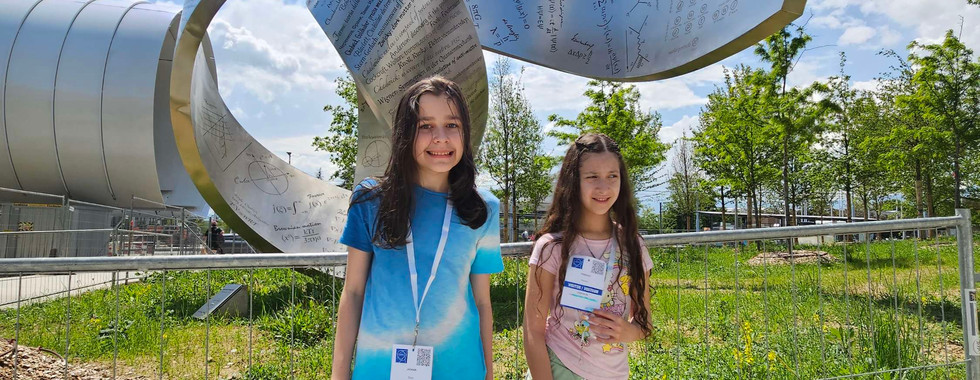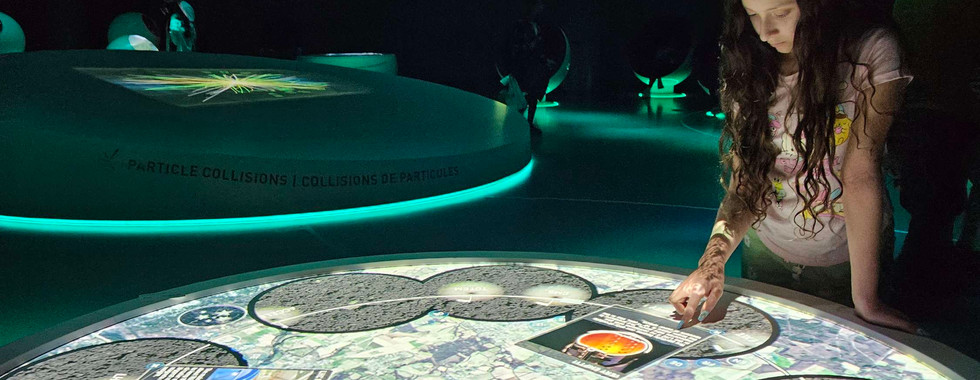
In January 2022, I took an online class, String Theory: Bringing General Relativity and Quantum Physics Together, with Ms. Julia Ruth. It was an exciting class, so I asked my mom to help me learn more by visiting a physicist. It was on Valentine's Day that my mom emailed Dr. Happer to ask if he would be willing to meet with me to discuss the field of physics. He responded immediately, inviting me so I knew I was in for something extraordinary. We left the house and headed for Princeton, New Jersey, that evening. We arrived at 11:30 p.m.!
The next afternoon, we arrived at Princeton University's Physics Department and waited for Dr. Happer. To everyone's surprise and amazement, Dr. Happer rode in on a bicycle at 30 degrees Fahrenheit, which made me think he was adventurous and daring. He welcomed us into his office. We needed many extra chairs because my entourage joined me on the trip. My entourage included my mom, dad, Painter Doug, and Dan, who graduated from Princeton with a Master's in Physics in 1967.
Here is some more background on Dr. Happer:
"William Happer is an American physicist specializing in studying atomic physics, optics, and spectroscopy. He is the Cyrus Fogg Brackett Professor of Physics, Emeritus, at Princeton University, and a long-term member of the JASON advisory group, where he pioneered the development of adaptive optics. A long-time member of JASON, a group of scientists that provides independent advice to the U.S. government on science, technology, and national security, Dr. Happer served as Director of the U.S. Department of Energy's Office of Science from 1991–1993."
We started with introductions and discussed the visible spectrum seen in the colors of the rainbow. I asked a question that Max Planck, a German theoretical physicist in the 1900s, pondered, "Why is purple at the end of the visible spectrum when people mix blue and red to see purple?" This is because human eyes do not perceive colors directly as they are in the spectrum. When you mix blue and red paint, you see purple, but it's just blue and red that your eyes can't separate. I think this is how Max Planck was inspired to develop his groundbreaking theory of quantum mechanics.
So, here's a fun fact: You only see three colors in total. You think you see the visible spectrum, but your eyes trick you. You only see the colors Red, Blue, and Yellow. That leads us to the fact that when you mixed that paint as a child, it wasn't purple on your canvas; no, it was only red and blue.
Did you know, "Every day, a normal human exhales around 1 kg or 2.3 lbs of CO2 -- the simplest chemically stable molecule of carbon in the earth’s atmosphere."
Since we are primarily composed of carbon, why are we always taught about the hazards of carbon in school? In "The Truth about Greenhouse Gases" Dr. Happer writes, " Before the industrial period, the concentration of CO2 in the atmosphere was about 270 parts per million (ppm). At the present time, the concentration is about 390 ppm, 0.039% of all atmospheric molecules and less than 1% of that in our breath. About fifty million years ago, a brief moment in the long history of life on earth, geological evidence indicates, CO2 levels were several thousand ppm, much higher than now. And life flourished abundantly."

With a rich academic background and having graduated from Princeton University in 1964, Dr. Happer's insights and wisdom were ready to be shared. I asked Dr. Happer how he deals with all the skeptics about his research on Climate Change, especially when he says the Earth is starved for CO2 rather than the abundance of it. To answer my question, he told me a story about his experiences growing up. He recounted when he was ten years old and stood up for what he believed was right, even when it meant going against the norm. This tale from his childhood served as a powerful reminder that doing what's right isn't always easy, but it can make a big difference in the world.

As the meeting concluded, I couldn't help but marvel at Dr. Happer's breadth of knowledge and passion. With a promise of future encounters, I bid adieu to the world of physics and embarked on my next adventure—imagining myself leaping into a black hole and transcending to the cat dimension.
I learned some valuable lessons and delved deeper into the world of physics. In 2022, I was accepted into the University of Maryland's Advanced Girls Physics Camp, which was a really fun way to learn about different careers in the Physics World. During the camp, I had a chance to encounter a researcher at CERN on a virtual tour. The following year, in 2023, I toured the CERN in person in Geneva, Switzerland. Physics and mathematics are my favorite subjects, and my learning journey in these fields will persist.
I am grateful to Dr. Happer for his time and inspiration! Will I attend Princeton??? Guess in the comments below!
So, until we meet again, I leave you with these captivating insights. Sayonara, from Kashmir, is ready to embrace the mysteries that lie ahead. And remember, the journey of discovery never truly ends.




















































Comments